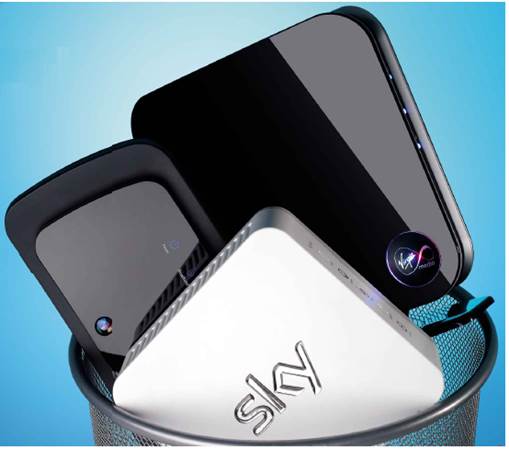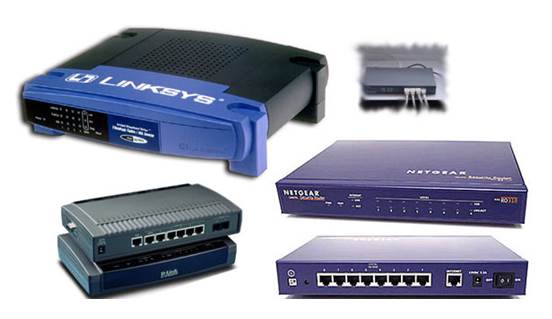Most major ISPs supply a router for
free when you sign up to their broadband services, but are those units holding
back your Wi-Fi speeds? We've pitched BT, Sky and Virgin Media's offerings
against nine third-party routers to find out if it's worth switching
Buyer's guide
ISP-supplied routers, like other areas of
the wireless industry, have been steadily improving over the years. Once, they
were hardly worth the plastic and precious metals from which they were made,
but they now offer better performance, and some unique and interesting
features.
Sky and BT offer channel-hopping
interference dodging in their routers, while Virgin Media combines cable modem
and 5 GHz support in its bundled offering.
So, why should you make the switch? What
makes a third-party router deserving of your cash? The answers are threefold:
features, flexibility, and vastly increased wireless speed and coverage.

ISP-supplied
routers, like other areas of the wireless industry, have been steadily
improving over the years
Despite those improvements, the
ISP-supplied routers are basic devices. Only one has a USB socket (useful for
sharing storage, or networking printers). None of them have advanced,
router-centric, category-based parental controls. And none of them offer
smartphone or tablet apps for router and network management . The best
third-party routers take all this in their stride.
They’re also limited when it comes to flexibility.
None of the ISP routers support concurrent dual-band networks, essential if you
want to connect older devices as well as benefit from the increased speed and
stability of 5GHz networking. None make it particularly easy to access the
router remotely, either, whereas D-Link, Asus and Cisco Linksys all have their
own dynamic DNS services that make it a doddle.
All the ISP-supplied routers we’ve tested
this month are locked to their respective broadband services, too. Even if you
did want to take them elsewhere, there’s no way to do it. Contrast that with
the Netgear routers in this Labs, which can be used on both ADSL and cable
connections. Even the single-connection routers reviewed in this Labs can be
carted from service to service.

Despite
those improvements, the ISP-supplied routers are basic devices
And, of course, you only get access to the
latest technology namely 802.11ac - if you opt for a third-party router. We
have three routers with this onboard in the Labs this month, and they all promise
superfast wireless speeds of up to 1.3Gbits/sec. The new standard can achieve
these results by supporting wider channels in the 5GHz spectrum (up to 160MHz
versus 40MHz) and more MIMO spatial streams. Although 802.11ac is still under
development (it’s at the draft 5 stage), these routers are still
backwards-compatible with 802.11n devices, so early adopters aren’t negatively
impacted.
Whether or not you opt for the latest
technology, though, there are some fantastic wireless routers reviewed in this
Labs that have the potential to super-charge your wireless network, and whisk a
high-speed broadband connection to every corner of your home. If you don’t make
the switch, you’ll never know what you’re missing.
How We Test
Testing wireless routers is tricky. Not
only do we need to provide an idea of how fast a router can be, but we also
need to be able to indicate how well it performs at short and long ranges, and
test performance in both the 2.4GHz and 5GHz frequency bands.

Netgear
WGR614 802 11g b Wi-Fi
To test these elements, we use two laptops
running Windows 7: one connected to the test router via a wired connection to
eliminate bottlenecks, and the other connected via wireless, using the 3x3 MIMO
stream-capable Intel Wi-Fi Link 5300 chipset. We then set up each router to use
WPA2 security with AES encryption and, if possible, enable channel bonding to
ensure maximum performance.
To assess speed, a series of large and
small files is copied between Windows shares on the two laptops. We run these
tests in the 2.4GHz frequency band, then over 5GHz at a range of 2.5m, to
assess top speed. For the 802.11ac routers, we test again using the
manufacturer’s own 802.11ac USB adapter; none of the manufacturer’s USB
adapters could complete the long-range test, though, which is why you won’t see
the figures in the feature table.
Next, we repeat the tests in each frequency
band, and over 802.11ac, with the wireless laptop placed at a distance of 40m
from the router, with one 19mm-thick wooden wall and a double-glazed window in
the way. This test indicates how each router performs at long range. There’s a
full breakdown of speed figures in the feature table and graphs.
During testing, we monitor the airwaves
using another laptop equipped with a Wi-Spy DBx radio-frequency spectrum
analyzer. Supplied by MetaGeek (www.metageek.net), this allows us to ensure
each router is using the optimum channel, and that no other devices in the
vicinity are causing interference. Where available, we test the speed of each
device’s shared-storage feature. Using a portable USB 3 hard disk as the
source, we connect a laptop to an Ethernet port on the router, and use Iometer
to assess raw speed. Finally, we test for ADSL speed and reliability. Using a
DSLAM (the type of device your router talks to in the local telephone exchange)
loaned to us by DrayTek, we set up our own virtual private ISP, then carry out
a series of small- and large-file downloads and uploads over an FTP link,
measuring the speed.